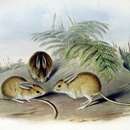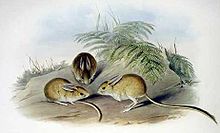ar
الأسماء في صفحات التنقل


Die Rehbraune Australische Hüpfmaus (Notomys cervinus), auch als Kitz-Hüpfmaus bezeichnet[1], ist ein Nagetier aus der Gattung der Australischen Hüpfmäuse, das in der zentralaustralischen Wüste heimisch ist.
Wie alle Australischen Hüpfmäuse hat die Rehbraune Australische Hüpfmaus kräftige Vorderzähne, einen langen Schwanz, dunkle Augen, große Ohren, gut entwickelte Hüften und sehr lange, schmale Hinterfüße. Die Kopf-Rumpf-Länge beträgt 95 bis 120 mm. Das Gewicht beträgt zwischen 30 und 50 g. Die Färbung variiert von hell rosa-rehbraun bis grau an der Oberseite und weiß an der Unterseite. Der 120 bis 160 mm lange Schwanz ist zweifarbig (weiß an der Unterseite und dunkler an der Oberseite) und endet in einem dunklen Pinsel. Die Ohren sind rund, die dunklen Augen sind besonders groß und die Tasthaare sind 65 mm lang. Der Weibchen haben vier Bauchzitzen.
Der bevorzugte Lebensraum der Rehbraunen Australischen Hüpfmaus sind die Geröllebenen und Lehmpfannen im Becken des Lake Eyre. Das Verbreitungsgebiet umfasst Teile des nördlichen South Australia und das äußerste südwestliche Queensland. Aufzeichnungen aus dem späten 19. Jahrhundert belegen, dass das frühere Verbreitungsgebiet größer war.
Die Rehbraune Australische Hüpfmaus lebt in kleinen Familienverbänden von zwei bis vier Individuen. Während des Tages suchen sie Unterschlupf in Bauten, die flacher sind, als die der sandbewohnenden Art Notomys fuscus, aber dennoch bis ein Meter tief sind und zwischen ein und drei Ausgänge haben. Während der Nacht legen sie Hunderte von Metern bei der Nahrungssuche zurück. Sie ernähren sich von Samen, Keimen und Insekten. Wie andere Australische Hüpfmäuse kommt die Art ohne Wasser aus, sie ist jedoch in der Lage, stark salzhaltiges Wasser zu verstoffwechseln, wenn es verfügbar ist. Nach einer Tragzeit von 38 Tagen bringen die Weibchen ein bis fünf vollentwickelte Junge zur Welt.
Der IUCN listet die Art in der Kategorie „gefährdet“ (vulnerable). Der Bestand wird auf weniger als 10.000 Alttiere geschätzt. Die Ursachen für die Gefährdung sind unbekannt, jedoch werden der Klimawandel, Destabilisierung und Erosion bedingt durch das Zertrampeln der Böden durch Huftiere sowie die Nachstellung durch Beutegreifer für wahrscheinlich gehalten.
Die Rehbraune Australische Hüpfmaus (Notomys cervinus), auch als Kitz-Hüpfmaus bezeichnet, ist ein Nagetier aus der Gattung der Australischen Hüpfmäuse, das in der zentralaustralischen Wüste heimisch ist.
The fawn hopping mouse (Notomys cervinus) is a rodent native to the central Australian desert. Like all hopping mice it has strong front teeth, a long tail, dark eyes, big ears, well-developed haunches and very long, narrow hind feet. It weighs between 30 and 50 g (1.1 and 1.8 oz). (Compare with the common house mouse, at 10 to 25 g (0.35 to 0.88 oz).)
The coloration of the fawn hopping mouse varies from pale pinkish-fawn to grey on the upper parts, and white underneath. The tail is 120 to 160 mm (4.7 to 6.3 in) long, bicoloured (white underneath, darker below), and ends in a dark brush. The ears and round, dark eyes are particularly large, and the whiskers even more so: 65 mm (2.6 in) in a creature that is only 95 to 120 mm (3.7 to 4.7 in) long.
The favoured habitat is the sparsely vegetated arid gibber plains and claypans of the Lake Eyre Basin, including parts of northern South Australia, far south-western Queensland and possibly the Northern Territory, though this last is uncertain. Records from the late 19th century show that its former range was more extensive including western New South Wales.[2]
Breeding is thought to be opportunistic. In captivity, gestation is about 40 days and between one and five fully furred young are born.
Fawn hopping mice live in small family groups of two to four individuals. During the day, they shelter in burrows which are simpler and shallower than those of the sand-dwelling dusky hopping mouse but nevertheless up to a metre deep with between one and three entrances. At night, they forage outwards for hundreds of metres, searching for seeds, and also taking green shoots and insects if the opportunity presents itself. As with other hopping mice, they do not need to drink, though they can metabolise highly saline water if it is available.
The fawn hopping mouse is classified as vulnerable. The causes of its decline are unknown, but assumed to be habitat degradation, competition for food with introduced species, and predation by introduced cats and foxes.

The fawn hopping mouse (Notomys cervinus) is a rodent native to the central Australian desert. Like all hopping mice it has strong front teeth, a long tail, dark eyes, big ears, well-developed haunches and very long, narrow hind feet. It weighs between 30 and 50 g (1.1 and 1.8 oz). (Compare with the common house mouse, at 10 to 25 g (0.35 to 0.88 oz).)
The coloration of the fawn hopping mouse varies from pale pinkish-fawn to grey on the upper parts, and white underneath. The tail is 120 to 160 mm (4.7 to 6.3 in) long, bicoloured (white underneath, darker below), and ends in a dark brush. The ears and round, dark eyes are particularly large, and the whiskers even more so: 65 mm (2.6 in) in a creature that is only 95 to 120 mm (3.7 to 4.7 in) long.
The favoured habitat is the sparsely vegetated arid gibber plains and claypans of the Lake Eyre Basin, including parts of northern South Australia, far south-western Queensland and possibly the Northern Territory, though this last is uncertain. Records from the late 19th century show that its former range was more extensive including western New South Wales.
Breeding is thought to be opportunistic. In captivity, gestation is about 40 days and between one and five fully furred young are born.
Fawn hopping mice live in small family groups of two to four individuals. During the day, they shelter in burrows which are simpler and shallower than those of the sand-dwelling dusky hopping mouse but nevertheless up to a metre deep with between one and three entrances. At night, they forage outwards for hundreds of metres, searching for seeds, and also taking green shoots and insects if the opportunity presents itself. As with other hopping mice, they do not need to drink, though they can metabolise highly saline water if it is available.
The fawn hopping mouse is classified as vulnerable. The causes of its decline are unknown, but assumed to be habitat degradation, competition for food with introduced species, and predation by introduced cats and foxes.
 From Gould, Mammals of Australia
From Gould, Mammals of Australia
Notomys cervinus es una especie de roedor de la familia Muridae.[2]
Se encuentra en Australia, exactamente en el suroeste de Queensland, noroeste de Nueva Gales del Sur, en Australia del Sur y el sur del Territorio del Norte.[3]
Notomys cervinus Notomys generoko animalia da. Karraskarien barruko Murinae azpifamilia eta Muridae familian sailkatuta dago.
Notomys cervinus est une espèce de rongeurs de la sous-famille des Murinés.
On la rencontre en Australie (Queensland, Nouvelles Galles du Sud, Australie du sud et Territoire du Nord).
Notomys cervinus est une espèce de rongeurs de la sous-famille des Murinés.
Il topo saltatore fulvo (Notomys cervinus Gould, 1851) è un roditore della famiglia dei Muridi diffuso in Australia.[1][2]
Roditore di piccole dimensioni, con la lunghezza della testa e del corpo tra 95 e 120 mm, la lunghezza della coda tra 120 e 160 mm, la lunghezza del piede tra 32 e 37 mm, la lunghezza delle orecchie tra 24 e 30 mm e un peso fino a 50 g.[3]
La pelliccia è lunga e soffice. Le parti superiori variano dal giallo-grigiastro al fulvo. Le parti ventrali, inclusa la parte del muso al disotto dei grandi occhi, e il dorso delle zampe sono bianchi. La coda è più lunga della testa e del corpo, brunastra sopra, biancastra sotto e con un ciuffo terminale di peli scuri. ci sono 13-14 anelli di scaglie per centimetro. Non sono presenti sacche golari; i maschi hanno un'area piatta di pelle ghiandolare larga 2-3 mm tra le zampe anteriori. Il cariotipo è 2n=48 FN=80.
È una specie terricola, notturna e gregaria. Si rifugia in semplici sistemi di tane e cunicoli.
Si nutre di semi, germogli e qualche insetto. Può sopravvivere a lungo senza acqua.
La riproduzione avviene quanto le condizioni ambientali sono favorevoli. Le femmine danno alla luce 1-5 piccoli alla volta dopo una gestazione di 38 giorni.
Questa specie è diffusa nel sud-ovest del Queensland e nel nord-est dell'Australia Meridionale.
Vive nelle pianure ciottolose del bacino del Lago Eyre.
La IUCN Red List, considerato il basso numero di individui adulti e il declino della qualità del proprio habitat, classifica N.cervinus come specie vulnerabile (VU).[1]
Il topo saltatore fulvo (Notomys cervinus Gould, 1851) è un roditore della famiglia dei Muridi diffuso in Australia.
엷은황갈색껑충쥐(Notomys cervinus)는 쥐과에 속하는 설치류의 일종이다.[2] 오스트레일리아 중부 지역 사막의 토착종이다.
엷은황갈색껑충쥐는 다른 껑충쥐들처럼 강한 앞 이빨과 긴 꼬리, 짙은 눈, 긴 귀, 잘 발달한 궁둥이, 아주 길고 좁은 뒷발을 갖고 있다. 몸무게는 30~50g이다.(흔하게 발견되는 생쥐류는 보통 10~25g이다.)
털 색은 연한 핑크색의 황갈색부터 상체의 회색, 하체의 흰색까지 다양하다. 꼬리는 길이가 120~160mm이고 두 가지 색을 띠며(윗면은 짙고 아랫면은 희다.), 꼬리 끝은 짙은 붓꼬리 형태이다. 귀는 둥글고 짙은 색의 눈은 특히 크며, 수염이 65mm로 몸 길이에 비해 상대적으로 길다.(몸길이는 95~120mm이다.)
엷은황갈색껑충쥐가 좋아하는 서식지는 식물이 드문드문 있는 건조한 깁스 평원과 에어호 분지 점토질 지역으로 사우스오스트레일리아의 일부 북부 지역과 멀리 퀸즐랜드 주 남부-서부 지역이 포함되며, 확인되지는 않았지만 노던 준주 지역도 서식하는 것으로 추정된다. 19세기말 기록에 의하면 뉴사우스웨일스 지역까지 분포했다.[3] 번식은 그때 그때 상황에 맞게 이루어진다. 포획 상태에서 임신 기간은 약 40일이고, 털이 완전히 자란 상태의 1~5마리의 새끼를 낳는다. 2~4마리씩 작은 가족 집단을 이루고 산다. 낮에는 모래 지역에서 서식하는 검은껑충쥐보다 얕은 굴 속 은신처에서 시간을 보낸다. 그렇지만 1~3개의 입구는 최대 1미터까지 깊다. 밤에는 먹이인 씨앗을 찾아 수백미터 밖으로 이동하고 녹색 새싹과 곤충을 먹기도 한다. 다른 깡충쥐처럼 가능하다면 고농도 식염수 물질대사도 가능하지만 반드시 마실 필요는 없다.
준위협종으로 분류된다. 개체수가 감소 추세를 보이는 이유는 알려져 있지 않지만, 도입종과의 경쟁과 서식지 악화, 도입종 고양이와 여우같은 포식자 때문으로 추정하고 있다.